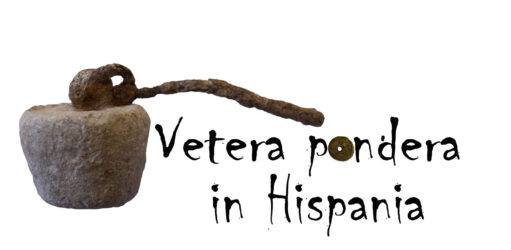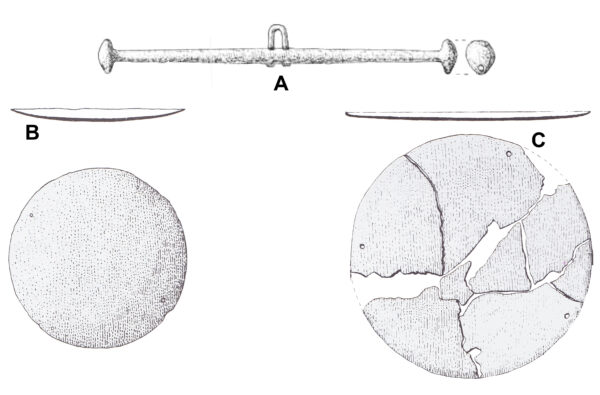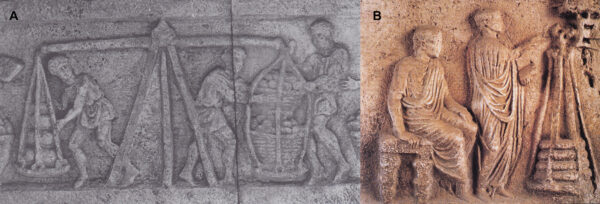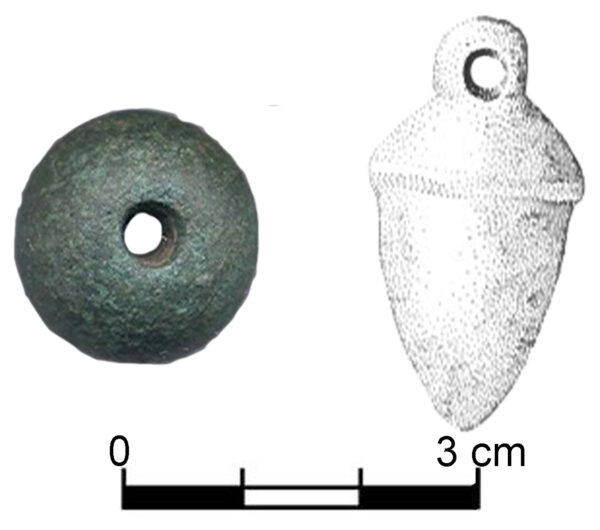
The main objective of the project presented here, managed by Dra. Cruces Blázquez Cerrato, is to compile and document all evidence of weights and scales found in the Iberian Peninsula, from the earliest items, dating from the end of the Bronze Age, to those from the High Imperial period. This initiative has its starting point in two previous projects funded by the Directorate General of Heritage of the Castilla y León Regional Government (B2020/003989 and 35.SUBV-21/235-VP), which were awarded to Diego Barrios Rodríguez and were aimed at reviewing these types of instruments in the collections of different museums in Castilla y León.

The work team developing this project is formed by Dr. Cruces Blázquez Cerrato (Professor of Archaeology at the University of Salamanca; crucesb@usal.es) and Diego Barrios Rodríguez who, since January 2022, enjoys a pre-doctoral contract co-funded by the JCyL and the ESF (Order EDU/875/2021; diebr@usal.es). The specific subject of the thesis, currently being carried out under the direction of Dr. Blázquez and within the PhD Programme in Prehistory and Ancient Sciences at the University of Salamanca, is dedicated to the study of systems of weights in the Iberian Peninsula in Antiquity: mentions in the sources, weighing instruments and their archaeological contexts.
The Vetera Pondera in Hispania Project aims to identify, document and record all objects related to the use of weight systems during Prehistory and Antiquity in the Iberian Peninsula. In this way, we should recall that the appearance, size and weight of these instruments vary significantly depending on the geographical region, historical period, and weight system. Although the use of metal was essential to measure the exchanges, specific conditions existed in each place and culture.
Thus, from Late Prehistory and during Antiquity metallic materials were used to make several types of instruments for weighing. These were, in first place, a basic tool such as the two-arms balance (libra), with its pans, and the asymmetric arms balance (statera), commonly known as a steelyard balance. The former, the two-arms balance, is able to compare an item and a weight value by using a piece which represents and corresponds to the unit, fraction or multiple of the weight system. This type of instrument is formed by a horizontal beam (scopus), with a vertical pointer (iugum) in the middle that splits the horizontal beam into two arms, at whose ends hang the scale pans supported by chains. The most ancient objects are dated in the first half of the third millennium BC and are found in both domestic and funerary contexts.
 Fig. 1. a) Balance arm from Grande Tossal de Redo (Calaceite, Teruel); length: 134 mm; diam. section: 5 mm (Lucas, 1990: 63); b) balance pan found in the Tomb 145 at El Cigarralejo (Mula, Murcia); diam. 70 mm (Cuadrado, 1987: 45); c) balance pan found in Tomb 305 at El Cigarralejo (Mula, Murcia); diam. 90 mm (Cuadrado, 1987: 45).
Fig. 1. a) Balance arm from Grande Tossal de Redo (Calaceite, Teruel); length: 134 mm; diam. section: 5 mm (Lucas, 1990: 63); b) balance pan found in the Tomb 145 at El Cigarralejo (Mula, Murcia); diam. 70 mm (Cuadrado, 1987: 45); c) balance pan found in Tomb 305 at El Cigarralejo (Mula, Murcia); diam. 90 mm (Cuadrado, 1987: 45).
The appearance of the asymmetric arms balance (statera) is dated in the third century BC, during the Hellenistic period. This tool achieves the same object using less force than librae thanks to the lengthening of one of its arms. This situation makes it easier to weigh items because it allows the calculation of the weight of objects with smaller standard masses. Therefore, a statera has a similar structure to a libra, but uses a counterweight (aequipondium).
 Fig. 2. a) Relief of the funerary monument of Marcus Vergilius Eurysaces, dated 30-20 BC (Corti, 2001: 162, fig. 94); b) Funerary relief from Capua dated in the second century AD (Corti, 2001: 146, fig. 78).
Fig. 2. a) Relief of the funerary monument of Marcus Vergilius Eurysaces, dated 30-20 BC (Corti, 2001: 162, fig. 94); b) Funerary relief from Capua dated in the second century AD (Corti, 2001: 146, fig. 78).
Both counterweights and weights are pieces with a determined and controlled mass based on a metrological system that gives them a value within the officially recognised standard weight. These objects, which are used as value references, are generally made of metal, although they were also made of stone and even ceramics. To differentiate between counterweights and weights, it should be borne in mind that the latter (pondera), since they were associated with librae, did not require suspension elements, and that they were sometimes perforated so that they could be inserted into a wire or shank to hold the whole together. On the other hand, the counterweights (aequipondia) used for weighing with staterae necessarily needed a suspension element, generally a ring, but their weight, given their function, does not have to correspond to an exact value within the weight standard in use.
 Fig. 3. a) Bronze weight from Cabeça de Vaiamonte (Monforte, Portoalegre, Portugal); diam.: 26.5 mm (Barrios, 2020: 1321: fig. 3, no. 5 and http://www.matriznet.dgpc.pt/MatrizNet/Objectos/ObjectosConsultar. aspx?IdReg=1029178); b) lead acorn-shaped counterweight from Conimbriga (Condeixa-a-Nova, Portugal); Weight: 56.9 g (Alarçao and Étienne, 1979: plate XLVIII).
Fig. 3. a) Bronze weight from Cabeça de Vaiamonte (Monforte, Portoalegre, Portugal); diam.: 26.5 mm (Barrios, 2020: 1321: fig. 3, no. 5 and http://www.matriznet.dgpc.pt/MatrizNet/Objectos/ObjectosConsultar. aspx?IdReg=1029178); b) lead acorn-shaped counterweight from Conimbriga (Condeixa-a-Nova, Portugal); Weight: 56.9 g (Alarçao and Étienne, 1979: plate XLVIII).